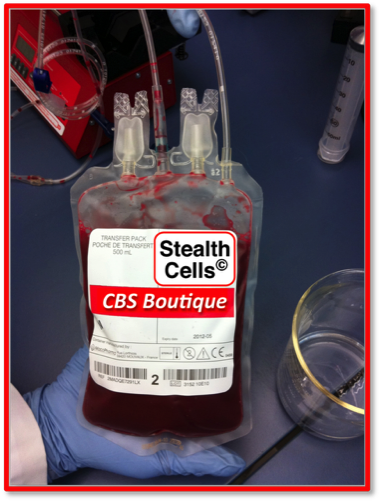Over the last several years our laboratory has pioneered the development of the 'immunocamouflage' of foreign cells and tissues via cell surface modification with biocompatible polymers such as methoxypoly(ethylene glycol) [mPEG] and polyoxazolines [POZ]. The immunocamouflage of cells arises due to polymer obfuscation of the cell surface charge as well as the physical (steric) camouflage of antigenic epitopes by the highly mobile nanoscale grafted polymer structures. As a consequence, allorecognition of donor cell is dramatically attenuated. Our initial application of this 'stealth' technology has been in transfusion medicine (1996 - present) as a means of preventing RBC alloimmunization of the non-A/B blood groups.

The 'immunocamouflage' of foreign cells and tissues via cell surface modification with biocompatible polymers such as methoxypoly(ethylene glycol) [mPEG] can be used to modulate the immune response both in vitro and in vivo. This immune modulation arises consequent to the upregulation of regulatory T cells (Tregs) and the down regulation of effector (Teff; pro-inflammatory) T cells. The INCREASE in the Treg:Teff ratio induces a tolerogenic state in the treated animal.
Using bioreactor systems, the 'immunocamouflage' of leukocytes can be used to generate microRNA (miRNA) that can be administered in vitro or in vivo to induce either tolerance of a proinflammatory state. These miRNA biologics are stable and highly effective. the miRNA biologics modulate the immune system by regulating the Treg:Teff ratio.


Our initial work on the immunocamouflage of cells was focused on this problem and led to the development of the "Stealth RBC". By grafting methoxy(Poly Ethylene) glycol to the membrane of normal donor RBC we camouflage the non-ABO antigens from immune recognition (ie., immunocamouflage) by the blood recipient.
This approach is being actively pursued within Canadian Blood Services as a means to address the transfusion needs of patients with severe alloimmunization or extremely rare blood types.

Relevant Laboratory Publications
Scott, M.D., Murad, K.L., Koumpouras, F., Talbot, M., and Eaton, J.W. Chemical camouflage of antigenic determinants: “Stealth” erythrocytes. Proc. Nat. Acad. Sci. USA, 94:7566-7571(1997. DOI: https://doi.org/10.1073/pnas.94.14.7566
Scott, M.D., Murad, K.L., and Eaton, J.W. The other blood substitute: Antigenically inert erythrocytes. In: Advances in Blood Substitutes: Industrial Opportunities and Medical Challenges (Winslow, R.M., Vandegriff, K.D., and Intaglietta, M. eds) Birkhuser, Boston. pgs. 133-150(1997). DOI: https://doi.org/10.1007/978-1-4612-1976-7_7
Scott, M.D. and Murad, K.L. Cellular camouflage: Fooling the immune system with polymers. Current Pharmaceutical Design, 4:423-438(1998). PMID: 10197054
Murad, K.L., Mahany, K.L. Kuypers, F.A., Brugnara, C., Eaton, J.W, and Scott, M.D. Structural and functional consequences of antigenic modulation of red cells with methoxypoly(ethylene glycol). Blood, 93:2121-2127(1999). PMID: 10068687
Murad, K.L., Gosselin, E.J., Eaton, J.W. and Scott, M.D. Stealth Cells: Prevention of MHC Class II mediated T cell activation by cell surface modification. Blood, 94:2135-2141(1999). PMID: 10477744
Scott, M.D. Bradley, A.J., and Murad, K.L. Camouflaged Blood Cells: Low technology bioengineering for transfusion medicine? Transfusion Medicine Reviews, 14:53-63 (2000). DOI: https://doi.org/10.1016/s0887-7963(00)80115-7
Chen, A.M. and Scott, M.D. Current and Future Applications of Immunologic Attenuation Via PEGylation of Cells and Tissues. BioDrugs, 15:833-847(2001). DOI: https://doi.org/10.2165/00063030-200115120-00005
Bradley, A.J. Test, T.T., Murad, K.L., Mitsuyoshi, J. and Scott, M.D. Interactions of IgM ABO Antibodies and complement with methoxy-PEG-modified human RBCs. Transfusion, 41:1225-1233(2001). DOI: https://doi.org/10.1046/j.1537-2995.2001.41101225.x
Bradley, A.J., Murad, K.L., Regan, K.L., and Scott, M.D. Biophysical consequences of linker chemistry and polymer size on stealth erythrocytes: Size does matter. Biochimica et Biophysica Acta, 1561:147-58(2002). DOI: https://doi.org/10.1016/s0005-2736(02)00339-5
Chen, A.M. and Scott, M.D. Immunocamouflage: Prevention of transfusion-induced graft-versus-host disease via polymer grafting of donor cells. Journal of Biomedical Materials Research, 67A:626-636(2003). DOI: https://doi.org/10.1002/jbm.a.10146
Scott, M.D. Bradley, A.J., and Murad, K.L. Stealth Erythrocytes: Effects of polymer grafting on biophysical, biological and immunological parameters. Blood Transfusion, 3:245-266(2003). Download Link: http://www.bloodtransfusion.it/articolo.aspx?idart=000165
Scott, M.D., and Chen, A.M. Beyond the red cell: Pegylation of other blood cells and tissues (Traitement par PEG des celllules sanguines et autres tissus). Transfusion Clinique et Biologique, 11:40-46(2004). DOI: https://doi.org/10.1016/j.tracli.2003.12.005
Bradley, A.J. and Scott, M.D. Separation and purification of methoxypoly(ethylene glycol) grafted red blood cells via two-phase partitioning. J. Chromatogr. B., 807:163-168 (2004). DOI: https://doi.org/10.1016/j.jchromb.2004.03.054
Scott, M.D. Inactivation of Prion Proteins Via Covalent Grafting with Methoxypoly(Ethylene Glycol). Medical Hypotheses, 66:387-393(2006). DOI: https://doi.org/10.1016/j.mehy.2005.08.049
McCoy, L.L and Scott, M.D. Broad spectrum antiviral prophylaxis: Inhibition of viral infection by polymer grafting with methoxypoly(ethylene glycol). In: Antiviral Drug Discovery for Emerging Diseases and Bioterrorism (Editor: Torrence, P.F.) Wiley & Sons, Hoboken, NJ. pp. 379-395.(2005). DOI: https://doi.org/10.1002/0471716715.ch16
Chen, A.M. and Scott, M.D. Immunocamouflage: Comparative analysis of polymer and linker chemistries on the efficacy of immunocamoulfage of murine cells. Artificial Cells, Blood Substitutes, and Biotechnology, 34:305-322(2006). DOI: https://doi.org/10.1080/10731190600683845
Bradley, A.J. and Scott, M.D. Immune complex binding by immunocamouflaged [poly(ethylene glycol)] erythrocytes. Am. J. Hematology, 82:970-975(2007). DOI: https://doi.org/10.1002/ajh.20956
Rossi, N.A., Zou,Y., Scott, M.D. and Kizhakkedathu, J.N. RAFT Synthesis of Acrylic Copolymers Containing Poly(ethylene glycol) and Dioxolane Functional Groups: Toward Well-Defined Aldehyde Containing Copolymers for Bioconjugation. Macromolecules, 41:5272-5282 (2008). DOI: https://doi.org/10.1016/j.biomaterials.2008.09.057
Le, Y. and Scott, M.D. Immunocamouflage: The Biophysical Basis of Immunoprotection by Grafted Methoxypoly(Ethylene Glycol) [mPEG]. Acta Biomaterialia, 6:2631-2641 (2010). DOI: https://doi.org/10.1016/j.actbio.2010.01.031
Sutton, T.C. and Scott, M.D. The Effect of Methoxypoly(Ethylene Glycol) Chain Length on the Inhibition Of Respiratory Syncytial Virus (RSV) Infection And Proliferation. Biomaterials, 31:4223-2230 (2010). DOI: https://doi.org/10.1016/j.biomaterials.2010.01.095
Rossi, N.A.A.; Constantinescu, I.; Scott, M.D.; Brooks, D.E.; Kizhakkedathu, J.N. Enhanced cell surface polymer grafting in concentrated and non-reactive aqueous polymer solutions. J. Am. Chem. Soc., 132:3423-3430 (2010). DOI: https://doi.org/10.1021/ja909174x
Rossi, N.A.A.; Constantinescu, I.; Kainthan, R.K.; Brooks, D.E.; Scott, M.D..; Kizhakkedathu, J.N. Red blood cell membrane grafting of multi-functional hyperbranched polyglycerols. Biomaterials, 31:4167-4178 (2010). DOI: https://doi.org/10.1016/j.biomaterials.2010.01.137
Greco, C.A, Maurer-Spurej, E., Scott, M.D., Kalab, M., Nakane, N., and Ramirez-Arcos. PEGylation prevents bacteria-induced platelet activation and biofilm formation in platelet concentrates. Vox Sanguinis, 100:336-339 (2011). DOI: https://doi.org/10.1111/j.1423-0410.2010.01419.x
Kyluik, D.L., Sutton, T.C., Le, Y. and Scott, M.D. Chapter 7: Polymer-Mediated Broad Spectrum Antiviral Prophylaxis: Utility in High Risk Environments. In: Progress in Molecular and Environmental Bioengineering- From Analysis and Modeling to Technology Applications (Editor: Carpi, A.) Intech, ISBN 978-953-307-268-5. pp. 167-190 (2011). DOI: https://doi.org/10.5772/20920
Wang, D., Kyluik, D.L, Murad, K.L., Toyofuku, W.M., and Scott, M.D. Polymer-Mediated Immunocamouflage of Red Blood Cells: Effects of Polymer Size on Antigenic and Immunogenic Recognition of Allogeneic Donor Blood Cells. Science China – Life Sciences, 54:589-598 (2011). [NOTE: Cover Art and featured article] DOI: https://doi.org/10.1007/s11427-011-4190-x
Wang, D., Kyluik, D.L, Murad, K.L., Toyofuku, W.M., and Scott, M.D. 聚合物介导的红细胞免疫修饰:聚合物分子大小在血细胞抗原识别中的效果。中国科学:生命科学,年第41卷第6期:429-438 (2011) [封面论文,中英文双语]
Wang, D., Toyofuku, W.M., Chen, A.M. and Scott, M.D. Induction of Immunotolerance via mPEG Grafting to Allogeneic Leukocytes. Biomaterials 32:9494-9503 (2011). DOI: https://doi.org/10.1016/j.biomaterials.2011.08.061
Wang, D., Toyofuku, W.M., Scott, M.D. The Potential Utility of Methoxypoly(Ethylene Glycol)-Mediated Prevention of Rhesus Blood Group Antigen RhD Recognition in Transfusion Medicine. Biomaterials, 33:3002-3012. (2012) DOI: https://doi.org/10.1016/j.biomaterials.2011.12.041
Chapanian, R., Constantinescu, I. Brooks, D.E., Scott, M.D. and Kizhakkedatu, J.N. In vivo Circulation, Clearance, and Biodistribution of Polyglycerol Grafted Functional Red Blood Cells. Biomaterials, 33:3047-3057 (2012). DOI: https://doi.org/10.1016/j.biomaterials.2011.12.053
Wang, D., Toyofuku, W.M. Kyluik, D.L. and Scott, M.D. Chapter 7: Use of Flow Cytometry In The In Vitro and In Vivo Analysis of Tolerance/Anergy Induction By Immunocamouflage. In: Flow Cytometry-Recent Perspectives, (Editor: Schmid, I.) InTech, ISBN: 978-953-51-0626-5. (2012). Pages 133-150. DOI: https://doi.org/10.5772/37797 Link: Intech Web Page
Le, Y. Li, L., Wang, D. and Scott, M.D. Immunocamouflage of Latex Surfaces by Grafted Methoxypoly(Ethylene Glycol) [mPEG]: Proteomic Analysis of Plasma Protein Adsorption. Science China - Life Sciences, 55:191-201 (2012). [NOTE: Cover Art and featured article] DOI: https://doi.org/10.1007/s11427-012-4290-2
Le, Y. , 王敦成 and Scott, M.D. , 42:185-195 (2012). [封面论文,中英文双语]
Chapanian, R., Constantinescu, I., Rossi, N.A., Medvedev, N., Brooks, D.E., Scott, M.D., Kizhakkedathu, J.N. Influence of polymer architecture on antigens camouflage, CD47 protection and complement mediated lysis of surface grafted red blood cells. Biomaterials, 33(31):7871-7883 (2012). DOI: https://doi.org/10.1016/j.biomaterials.2012.07.015
Chapanian, R., Constantinescu, I., Brooks, D.E., Scott, M.D., Kizhakkedathu, J. Antigens Protected Functional Red Blood Cells By The Membrane Grafting Of Compact Hyperbranched Polyglycerols. Journal of Visual Experiments, 71:e50075, DOI: https://doi.org/10.3791/50075.
Chapanian, R., Constantinescu, I., Medvedev, N., Scott, M.D., Brooks, D.E., Kizhakkedathu, J. Therapeutic Cells via Functional Modification: Influence of molecular properties of polymer grafts on in vivo circulation, clearance, immunogenicity and antigen protection. Biomacromolecules, 14(6):2052-62 (2013). DOI: https://doi.org/10.1021/bm4003943
Kyluik-Price D.L., Li, L. and Scott, M.D. Comparative Efficacy of Blood Cell Immunocamouflage by Membrane Grafting of Methoxypoly(Ethylene Glycol) and Polyethyloxazoline. Biomaterials 35(1):412-422 (2014). DOI: https://doi.org/10.1016/j.biomaterials.2013.09.016
Li, L., Noumsi, G.T., Kwok, Y.Y.E., Moulds, J.M. and Scott, M.D. Inhibition of Phagocytic Recognition of Anti-D Opsonized Rh D+ RBC By Polymer-Mediated Immunocamouflage. American Journal of Hematology, 90(12):1165-1170 (2015). DOI: https://doi.org/10.1002/ajh.24211
Wang, D., Shanina, I., Toyofuku, W.M., Horwitz, M.S. and Scott, M.D. Inhibition of Autoimmune Diabetes in NOD Mice by miRNA Therapy. PLoS ONE 10(12): e0145179. (2015). DOI: https://doi.org/10.1371/journal.pone.0145179
Kyluik-Price D.L., Li, L. and Scott, M.D. Effects of Methoxypoly (Ethylene Glycol) Mediated Immunocamouflage on Leukocyte Surface Marker Detection, Cell Conjugation, Activation and Alloproliferation. Biomaterials 74(1):167-177 (2016). DOI: https://doi.org/10.1016/j.biomaterials.2015.09.047
Le, Y., Toyofuku, W.M. and Scott, M.D. Immunogenicity of Murine mPEG-Red Blood Cells and the Risk of Anti-PEG Antibodies in Human Blood Donors. Experimental Hematology 47(3):36-47 (2017). DOI: https://doi.org/10.1016/j.exphem.2016.11.001
Scott, M.D., Toyofuku, W.M., Yang, X., Raj, M. and Kang, N. Chapter 2: Immunocamouflaged RBC for Alloimmunized Patients. In: Transfusion Medicine and Scientific Developments (Editor: Koopman-van Gemert, A.), INTECH Book, pp. 23-42 (2017). ISBN: 978-953-51-3320-9. DOI: http://dx.doi.org/10.5772/intechopen.68647
Kang, N., Toyofuku, W.M., Yang, X. and Scott, M.D. Inhibition of Allogeneic Cytotoxic T Cell (CD8+) Proliferation Via Polymer-Induced Treg (CD4+) Cells. Acta Biomaterialia, 57:146–155 (2017). DOI: https://doi.org/10.1016/j.actbio.2017.04.025
Yang, X., Kang, N., Toyofuku, W.M., and Scott, M.D. Enhancing the Pro-Inflammatory Anti-Cancer T Cell Response Via Biomanufactured, Secretome-Based, Immunotherapeutics. Immunobiology, 224(2): 270-284 (2019). DOI: https://doi.org/10.1016/j.imbio.2018.12.003
Scott, M.D., Wang, D., Toyofuku, W.M., and Yang, X. Modulating the T Lymphocyte Immune Response via Secretome Produced miRNA: From Tolerance Induction to the Enhancement of the Anti-Cancer Response. In: Cells of the Immune System, (Editor: Ota Fuchs), INTECH Book, in press. ISBN: 978-1-78985-584-5 (2019). DOI: 10.5772/intechopen.86598
Scott, M.D., Nakane, N. and Maurer-Spurej, E. Cryoprotection of Platelets by Grafted Polymers. In: Cryopreservation (Editor: Quain, M.), INTECH Book. In press. ISBN: 978-1-83880-206-6 (2019). DOI: in press
Yang, X. and Scott, M.D. Biologic Modulation of the Treg:Teff Ratio: From Immunosuppression to Immunoactivation. In: Immunosuppression (Editor: Zakaria, M.), INTECH. Croatia. ISBN: 978-1-83968-124-0 (2020). Published online. Book due in 2020. DOI: 10.5772/intechopen.92038
Yang, X., Toyofuku, W.M., and Scott, M.D. Differential Leukocyte MicoRNA Responses Following Pan T Cell, Allorecognition and Allosecretome-Based Therapeutics Activation. Archivum Immunologiae et Therapiae Experimentalis, 69: article number: 30 [16 pages] (2021). DOI: 10.1007/s00005-021-00634-5

Consequent to our earlier work on polymer grafting to intact cells (e.g., RBC, lymphocytes), we hypothesized that mPEG-grafting to platelets would prevent platelet aggregation and phagocytic recognition of the transfused mPEG-platelets. Moreover, because soluble mPEG is a known cryoprotectant, we further hypothesized that the grafted polymer could also attenuate other ‘cold-induced’ mechanical lesions of the CSL induced by cold temperatures and even freezing of donor platelets.
The ability to freeze and recover donor platelets would both greatly increase platelet inventory and potentially expand the use of platelet therapy to geographic locations where platelet therapy is not commonly practiced. Moroever, the cold storage of platelets would significantly reduce the risk of microbial growth within platelet products thus enhancing patient safety.
Stealth RBC: Boutique RBC For the Discriminating Customer


UBC


